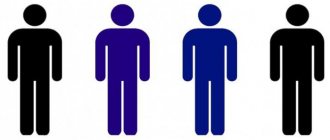The characteristics and properties of quasi-groups differ from those that are characteristic of other social associations. Let's take a closer look at them.
- Anonymity. People in a quasi-group often do not know each other; they do not feel control and responsibility to the group.
- Suggestibility. Members of such a group are easier to instill an idea in than people outside of it.
- Social contagion. People within a quasi-group pick up emotions from other members faster and change them at the same speed.
- Unconsciousness. A person within a quasi-group becomes less aware as an individual, succumbs to the instincts of the crowd and can be unpredictable.
What is a social group?
A social group is a collection of people, one way or another connected with each other and united by certain characteristics. Such signs may include age, religious and ideological views, membership in a subculture and other characteristics. A social group can be determined by one factor or a combination of several factors.
The minimum size of a social group depends on the purpose for which it is allocated. In certain situations it can be 2 people. But in most cases we are talking about groups that include at least several people. The maximum size of a social group is not limited and depends on how common the characteristic by which this group is distinguished is.
Examples of social groups:
- high school students;
- applicants to a particular university;
- athletes;
- young mothers on the playground;
- programmers;
- railway workers.
Social groups can be distinguished according to different characteristics, unite with each other, or, conversely, be divided according to some additional characteristic. For example, male and female students studying in the same university course can be considered as one generalized or two separate social groups (depending on the task).
Comparing a person with a certain social group allows us to understand his needs, interests, behavioral characteristics and other personal characteristics without knowing anything about him. That’s why this concept is so interesting to marketers.
Youth in modern society (grade 11)
The awareness of youth as a special stage in a person’s life, and of youth as a separate social group, occurred relatively recently by historical standards. In a traditional society, a person entered adulthood directly from childhood, without any intermediate stages. There were special rites of passage into adulthood. About a century ago, scientific study of the problems of young people began. Initially, the biological, physiological approach prevailed. The main reason for personality changes in adolescence was associated with human puberty. Gradually, more and more attention began to be paid to the role of social factors: the influence of the surrounding cultural environment, the nature of upbringing in the family and school, the influence of friends. It is social formation, the mastery of basic social roles that began to be considered as the main vector of personality development in adolescence. Typically, there are two stages on the path to growing up: adolescence and adolescence. However, the age limits for each stage are quite vague. In modern Russian psychology, the age of 11–15 years is most often considered to be adolescence, and the age of early adolescence is 16–18 years, but in some cases the upper limit is 20 years of age. From Western psychology the term “teenager” came to us, covering young people from 13 to 19 years old, that is, at the age designated by numerals ending in “teen” (thirteen–nineteen).
Signs of social groups
When grouping people into social groups, generalization is used based on the following characteristics:
- the presence of certain relationships between them;
- direct or indirect interaction between them;
- stability of the unifying feature;
- commitment to common ideas;
- having expectations regarding each other;
- feeling of belonging to a group;
- characteristic features of behavior;
- the presence of a certain internal organization (for example, in a company of friends, everyone is usually assigned a certain role).
A social group is an association of people who somehow relate themselves to each other. However, they do not necessarily interact directly with each other (for example, church parishioners may not know each other, but recognize that they are part of the association).
Reasons for the division of society
Humans are social by nature. They need communication and interaction with people like them. For a more comfortable relationship with the world, people have learned to unite into groups of their own kind based on certain characteristics.
Initially, these were informal associations into which people unintentionally fell. Gradually, formal organizations began to form, such as work collectives, schools, and others.
Due to lack of communication, people strive to join some group. For example, retirees often join political communities, attend classes for people like them, or join hobby groups. This is because it is human nature to live in society and will always strive for communication and social interaction.
When a person falls into one group or another, he feels more protected. For example, the Danes and Danish sociologists believe that this nation is the happiest precisely because people belong to certain categories. They have a very developed area of circles, communities of interests and other formations, when a person becomes part of a team.
In modern Russia, the movement of uniting people into teams is not so developed, but, nevertheless, people independently strive to take a position in any subgroup.
Classification of social groups
To better understand what a social group is, let’s look at the features of the classification of various groups. American sociologist Charles Cooley proposed dividing them into two types:
- Primary. Such groups bring together people who are directly related to each other, have emotional closeness or blood relationship.
- Secondary. Such groups include people united by some common interests, views or ideas. However, initially they have no personal or emotional attachment. This may be a trade union or the work collective of an enterprise.
Another common method of classification is based on the way in which the group internally organizes and regulates interactions between members. Within this classification, social groups are divided into:
- Formal. Such groups are usually associated with specific organizations, and the relationships between their members are subject to rules prescribed in official documents. An example of such a social group could be an enterprise team, a group or a stream of students.
- Informal. Such social groups arise spontaneously based on the presence of mutual interests among a sufficient number of people. An example of such a social group would be a group of friends or a group of young parents who walk with their children on the same playground.
Another characteristic that is often used is the degree to which an individual belongs to a particular group. This approach is used when it is necessary to show the attitude of a particular person to a social group. There are three possible options here:
- Ingroup. This is a social group with which a particular person associates himself. This could be your own confession, company, family, friends.
- Outgroup. A person evaluates such a social group as alien to himself. This could be someone else's denomination, another group at a university, or a team from another company.
- Reference group. This is a group with which a person does not identify himself, but wants to relate, focusing on their value system. The reference social group has two main functions: normative (gives a person a value system to navigate by) and comparative (allows him to evaluate himself and his successes at the current stage).
Another quite obvious sign for classification is numbers. According to it, all social groups are divided into two types:
- Small ones. This type usually includes groups of 2 to 30 participants. An example would be a family, a group of friends, or a school class.
- Big ones. This type includes groups in which the number of participants exceeds 30 (the upper limit is not indicated). This could be a trade union or a religious denomination.
Membership in social groups can change or remain the same throughout life. For example, place of birth, skin color, gender and some health characteristics do not change. Accordingly, according to these characteristics, a person belongs to certain social groups all his life. But at the same time, his age, social and family status, place of residence, income level and many other characteristics change, and therefore he moves between different groups.
Development of social roles in adolescence (grades 10-11)
Adolescence is a stage of personality development that usually begins at 11–12 and lasts until 16–17 years, the period when a person enters “adulthood.” At this time, the teenager’s life self-determination occurs, plans for the future are formed. There is an active search for one’s “I” and experimentation in different social roles. The teenager changes himself, tries to understand himself and his capabilities. The demands and expectations placed on him by other people change. He is forced to constantly adjust, adapt to new conditions and situations, but this does not always happen successfully. The internal crisis of a teenager’s self-esteem arises in connection with the expansion and growth of opportunities, on the one hand, and the preservation of child-school status, on the other. The young man’s worldview is being formed. Characteristic is the desire for leadership in a peer group. So, the social roles of youth: child for parents; student for teacher; leader in a peer group; conscript for the military registration and enlistment office; athlete in the section; older brother or sister, etc.
Methods of dividing into social groups
Let's look at a few of the most important features used by sociologists, marketers and other researchers to identify social groups.
- Age. Almost everything in a person’s life depends on this characteristic: his interests, social and family status, health and many other characteristics that are important for sociological, marketing and other research.
- Floor. A person’s sphere of interests, needs, health characteristics, lifestyle and much more also depend on gender.
- Territory of residence. This may be a specific region of residence or type of area (rural, urban).
- Profession. A social group identified on this basis may include representatives of a specific profession (doctor) or a certain specialization (surgeon, orthopedist, ophthalmologist).
- Religious affiliation. There are about 5,000 different religious movements in the world. Major religions have followers in the billions.
- Nationality. Despite the growing popularity of cosmopolitanism, most people in the world identify themselves with a particular nation.
Of course, one person, based on the listed characteristics, can be classified into several social groups. He will relate to some throughout his life (gender, nationality), others will change (age), and others he may change himself (profession, religious affiliation, place of residence).
Rules of behavior in a social group
Many social groups are characterized by certain rules of behavior called “group norms.” The most common group norms are:
- manner of speech, slang features;
- behavior style;
- clothing style, characteristic wardrobe items (cap, sneakers) or accessories (backpack, briefcase);
- customs and rituals;
- daily habits.
In formal social groups, adherence to group norms is often a requirement (for example, students must wear a uniform and bring a backpack or briefcase to school). In informal social groups there are no formal rules requiring adherence to group norms, but failure to comply may result in disrespect, lack of recognition, and other sanctions from other members.
Functions of social groups
Another important point in understanding what a social group is is knowing its functional significance (that is, the benefits it can bring to its members). Sociologists call the following functions of social groups:
- Expressive function. Every person needs the expression of his emotions, the approval of his views and ideas. His social group gives him the opportunity to express himself and provides him with respect and approval from other members.
- Emotional support. In any difficult situation, a person needs to feel that he is not alone and that he has a circle of emotionally close people. Sometimes it’s family or friends, and sometimes it’s like-minded people.
- Socialization. A social group can help a person find his place in society, meet potential friends, and find a life partner (read more about socialization in this article).
- Instrumental function. The importance of social groups in terms of mutual assistance cannot be underestimated. For example, national diasporas often help people find employment in a foreign country.
Differences between a social group and a social community
It is necessary to distinguish between the concepts of social group and social community. A social group is an association of people who somehow interact with each other or are related to each other, even if they do not know each other (for example, the team of a large corporation is a social group).
A social community is a certain set of people who are not related to each other , but are united by some common characteristic. In addition, unlike a social group, it can be a temporary association of people. For example, spectators who come to a cinema to watch a film are a social community, but not a group.
Youth subculture (grade 10)
The socio-psychological characteristics of youth as a social group are also manifested in the existence of a specific youth subculture (from Latin, sub - a particle indicating being under something, near something). The youth subculture is understood primarily as the culture of a certain young generation that has a common lifestyle, behavior, group norms, values and stereotypes. Youth consciousness is the basis, the bearer of a special subculture, secondary to the cultural environment of the adult population. As a special subculture, it has its own goals, values, ideals, illusions, which do not always and accurately replicate those dominant in adult society; it has its own language. In the youth subculture, as a complex and multidimensional phenomenon, in turn, smaller, but nevertheless strictly defined subcultures (punks, ravers, rockers, skins, acid youth, football and music fans, etc.) are distinguished. At the same time, it is possible to identify common features under the influence of which it is formed.









